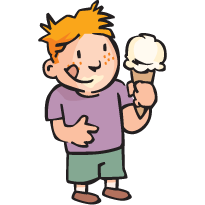Boston Children's Museum
308 Congress Street, Boston, MA 02210
617-426-6500
© Boston Children’s Museum 2024
Website Design by JackrabbitAn important part of experimentation and design activities is knowing how to manipulate “variables”. Variables are things you can change about a design or an experiment that will change the outcome of that design or experiment. In the first Ice Cream Science activity, no “variables” were changed, but the amount of sugar, vanilla or cream could have been altered and the flavor of the ice cream would probably have changed. Each of these ingredients is a variable. The kind of milk or cream used could also be a variable—making one batch of ice cream with milk and another with cream might yield two different results. In this activity, students will experiment with a very important variable—the ice used to freeze the ice cream.
Follow the preparation instructions from the first Ice Cream Science activity. If you prefer, you can use the instructions from the Ice Cream Science – A New Recipe instead, which will yield better results, but will require more materials. Have some water on hand as well.

Ask your students what it was like when they made ice cream in the first Ice Cream Science activity. What did they notice about the bags (or coffee cans, if you followed the Ice Cream Science – A New Recipe instructions)? Ask them if they remember using the ice and salt. Do they think they could make ice cream just with the ice?
You will divide your students into teams and ask them to choose from 4 different ways of making ice cream. They can use:
Have each team choose which of these options they would like to try. Hopefully each of the four choices will be attempted by at least one team. If not, try to persuade some teams to experiment with the un-chosen option or options. As a last resort, assign teams which kinds of ice solution they will use. It is important that each of the options are tried by at least one team.
Can you discover the best way to make ice cream?
After your students have been mixing and shaking their ice cream for a few minutes, ask them how long it took last time to make the ice cream. How long do they think it will take this time? They should keep shaking and squeezing their ice cream bags during this discussion.
After the same amount of time has passed that it took to make ice cream in the first activity, have your students stop and open up their bags. What do they notice? Who has ice cream similar to what they made last time? Who doesn’t have ice cream yet? Have all of the teams zip their bags up again and shake for 5 more minutes. Do they have ice cream now? Which teams do not? Record these results. What do they notice about the ice solutions that worked and about those that didn’t? Have the teams that did make ice cream share it with those that did not. Hand out the “tasting cups” or bowls and use the tasting method described in the suggestions section of the first Ice Cream Science activity.